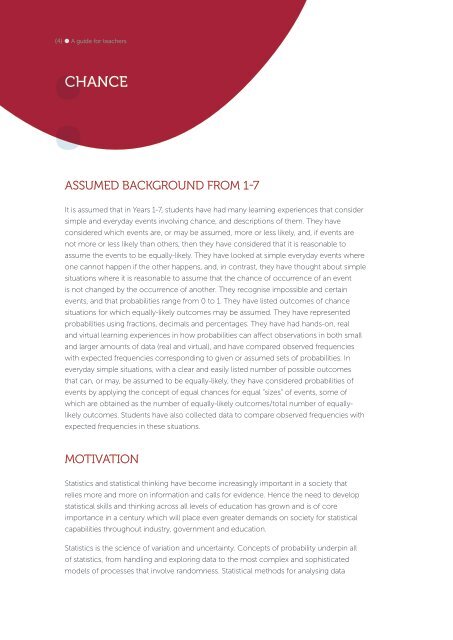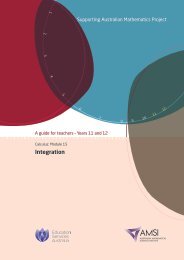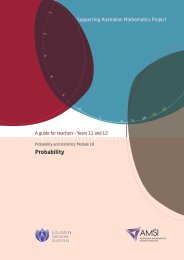PDF Version of module - the Australian Mathematical Sciences ...
PDF Version of module - the Australian Mathematical Sciences ...
PDF Version of module - the Australian Mathematical Sciences ...
You also want an ePaper? Increase the reach of your titles
YUMPU automatically turns print PDFs into web optimized ePapers that Google loves.
{4} A guide for teachersCHANCEASSUMED BACKGROUND FROM 1-7It is assumed that in Years 1-7, students have had many learning experiences that considersimple and everyday events involving chance, and descriptions <strong>of</strong> <strong>the</strong>m. They haveconsidered which events are, or may be assumed, more or less likely, and, if events arenot more or less likely than o<strong>the</strong>rs, <strong>the</strong>n <strong>the</strong>y have considered that it is reasonable toassume <strong>the</strong> events to be equally-likely. They have looked at simple everyday events whereone cannot happen if <strong>the</strong> o<strong>the</strong>r happens, and, in contrast, <strong>the</strong>y have thought about simplesituations where it is reasonable to assume that <strong>the</strong> chance <strong>of</strong> occurrence <strong>of</strong> an eventis not changed by <strong>the</strong> occurrence <strong>of</strong> ano<strong>the</strong>r. They recognise impossible and certainevents, and that probabilities range from 0 to 1. They have listed outcomes <strong>of</strong> chancesituations for which equally-likely outcomes may be assumed. They have representedprobabilities using fractions, decimals and percentages. They have had hands-on, realand virtual learning experiences in how probabilities can affect observations in both smalland larger amounts <strong>of</strong> data (real and virtual), and have compared observed frequencieswith expected frequencies corresponding to given or assumed sets <strong>of</strong> probabilities. Ineveryday simple situations, with a clear and easily listed number <strong>of</strong> possible outcomesthat can, or may, be assumed to be equally-likely, <strong>the</strong>y have considered probabilities <strong>of</strong>events by applying <strong>the</strong> concept <strong>of</strong> equal chances for equal “sizes” <strong>of</strong> events, some <strong>of</strong>which are obtained as <strong>the</strong> number <strong>of</strong> equally-likely outcomes/total number <strong>of</strong> equallylikelyoutcomes. Students have also collected data to compare observed frequencies wi<strong>the</strong>xpected frequencies in <strong>the</strong>se situations.MOTIVATIONStatistics and statistical thinking have become increasingly important in a society thatrelies more and more on information and calls for evidence. Hence <strong>the</strong> need to developstatistical skills and thinking across all levels <strong>of</strong> education has grown and is <strong>of</strong> coreimportance in a century which will place even greater demands on society for statisticalcapabilities throughout industry, government and education.Statistics is <strong>the</strong> science <strong>of</strong> variation and uncertainty. Concepts <strong>of</strong> probability underpin all<strong>of</strong> statistics, from handling and exploring data to <strong>the</strong> most complex and sophisticatedmodels <strong>of</strong> processes that involve randomness. Statistical methods for analysing data
















